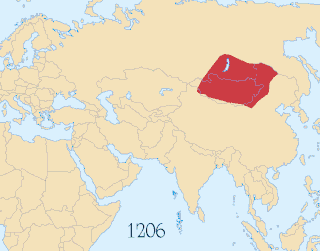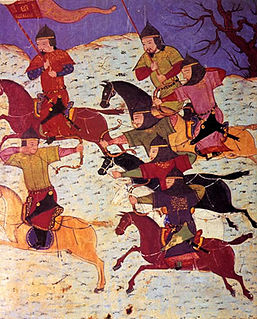
The 13th century was the century which lasted from January 1, 1201 through December 31, 1300 in accordance with the Julian calendar.

The 3rd century BC started the first day of 300 BC and ended the last day of 201 BC. It is considered part of the Classical era, epoch, or historical period.
This article concerns the 200 BC decade, that lasted from 209 BC to 200 BC'.
Montu was a falcon-god of war in ancient Egyptian religion, an embodiment of the conquering vitality of the pharaoh. He was particularly worshipped in Upper Egypt and in the district of Thebes.
[Ramesses II] whom victory was foretold as he came from the womb,
Whom valor was given while in the egg,
Bull firm of heart as he treads the arena,
Godly king going forth like Montu on victory day.

Thutmose III was the sixth pharaoh of the Eighteenth Dynasty. Officially, Thutmose III ruled Egypt for almost 54 years and his reign is usually dated from 28 April 1479 BC to 11 March 1425 BC, from the age of two and until his death at age fifty-six; however, during the first 22 years of his reign, he was coregent with his stepmother and aunt, Hatshepsut, who was named the pharaoh. While he was shown first on surviving monuments, both were assigned the usual royal names and insignia and neither is given any obvious seniority over the other. Thutmose served as the head of Hatshepsut's armies. During the final two years of his reign, he appointed his son and successor, Amenhotep II, as his junior co-regent. His firstborn son and heir to the throne, Amenemhat, predeceased Thutmose III.

The Mongol Empire of the 13th and 14th centuries was the largest contiguous land empire in history. Originating in Mongolia in East Asia, the Mongol Empire eventually stretched from Eastern Europe and parts of Central Europe to the Sea of Japan, extending northward into parts of the Arctic; eastward and southward into the Indian subcontinent, Mainland Southeast Asia and the Iranian Plateau; and westward as far as the Levant and the Carpathian Mountains.

The Battle of Kadesh or Battle of Qadesh took place between the forces of the New Kingdom of Egypt under Ramesses II and the Hittite Empire under Muwatalli II at the city of Kadesh on the Orontes River, just upstream of Lake Homs near the modern Lebanon–Syria border.

The New Kingdom, also referred to as the Egyptian Empire, is the period in ancient Egyptian history between the sixteenth century BC and the eleventh century BC, covering the Eighteenth, Nineteenth, and Twentieth dynasties of Egypt. Radiocarbon dating places the exact beginning of the New Kingdom between 1570 BC and 1544 BC. The New Kingdom followed the Second Intermediate Period and was succeeded by the Third Intermediate Period. It was Egypt's most prosperous time and marked the peak of its power.

The Battle of Megiddo was fought between Egyptian forces under the command of Pharaoh Thutmose III and a large rebellious coalition of Canaanite vassal states led by the king of Kadesh. It is the first battle to have been recorded in what is accepted as relatively reliable detail. Megiddo is also the first recorded use of the composite bow and the first body count. All details of the battle come from Egyptian sources—primarily the hieroglyphic writings on the Hall of Annals in the Temple of Amun-Re at Karnak, Thebes, by the military scribe Tjaneni.

Subutai was a Mongolian general and the primary military strategist of Genghis Khan and Ögedei Khan. He directed more than 20 campaigns and won 65 pitched battles, during which he conquered or overran more territory than any other commander in history as part of the expansion of the Mongol Empire. He often gained victory by means of imaginative and sophisticated strategies and routinely coordinated movements of armies that operated hundreds of kilometers apart from each other. Subutai is well known for the geographical diversity and success of his expeditions, which took him from central Asia to the Russian steppe and into Europe.

The Battle of the Kalka River was fought between the Mongol Empire, whose armies were led by Jebe and Subutai the Valiant, and a coalition of several Rus' principalities, including Kiev and Galich, and the Cumans. They were under the joint command of Mstislav the Bold and Mstislav III of Kiev. The battle was fought on May 31, 1223 on the banks of the Kalka River in present-day Donetsk Oblast, Ukraine, and ended in a decisive Mongol victory.

The Trịnh–Nguyễn Civil War was a long war waged between the two ruling families in Vietnam.

The Maratha Conquests were a series of conquests in the Indian subcontinent which led to the building of the Maratha Empire. These conquests were started by Shivaji in 1659 from the victory at the Battle of Pratapgad against Bijapur. The expansion of the empire was limited and interrupted by the Mughal conquests of south India by Emperor Aurangzeb. Marathas were forced to defend their territories against the overwhelmingly strong Mughal army in the 27 years long Deccan wars. They were able to defend their territories and gain an upper hand over Mughals in the sustained conflict.

The Eighteenth Dynasty of Egypt is classified as the first dynasty of the New Kingdom of Egypt, the era in which ancient Egypt achieved the peak of its power. The Eighteenth Dynasty spanned the period from 1549/1550 to 1292 BC. This dynasty is also known as the Thutmosid Dynasty for the four pharaohs named Thutmose.

This article discusses the political divisions and vassals of the Mongol Empire. Through invasions and conquests the Mongols established a vast empire that included many political divisions, vassals and tributary states. It was the largest contiguous land empire in history. However, after the death of Möngke Khan, the Toluid Civil War and subsequent wars had led to the fragmentation of the Mongol Empire. By 1294, the empire had fractured into four autonomous khanates, including the Golden Horde in the northwest, the Chagatai Khanate in the middle, the Ilkhanate in the southwest, and the Yuan dynasty in the east based in modern-day Beijing, although the Yuan emperors held the nominal title of Khagan of the empire.
The division of the Mongol Empire began when Möngke Khan died in 1259 in the Siege of Diaoyu Castle with no declared successor, precipitating infighting between members of the Tolui family line for the title of khagan that escalated into the Toluid Civil War. This civil war, along with the Berke–Hulagu war and the subsequent Kaidu–Kublai war, greatly weakened the authority of the great khan over the entirety of the Mongol Empire, and the empire fractured into autonomous khanates: the Golden Horde in Eastern Europe, the Chagatai Khanate in Central Asia, the Ilkhanate in Southwest Asia, and the Yuan dynasty in East Asia based in modern-day Beijing – although the Yuan emperors held the nominal title of khagan of the empire. The four divisions each pursued their own interests and objectives and fell at different times.

The Later Jin (1616–1636) was a dynastic khanate in Manchuria ruled by the Jurchen Aisin Gioro leaders Nurhaci and Hong Taiji. Established in 1616 by the Jianzhou Jurchen chieftain Nurhaci upon his reunification of the Jurchen tribes, its name was derived from the former Jurchen-led Jin dynasty which had ruled northern China in the 12th and 13th centuries before falling to the Mongol Empire. In 1635, the lingering Northern Yuan under Ejei Khan formally submitted to the Later Jin. The following year, Hong Taiji officially renamed the realm to "Great Qing", thus marking the start of the Qing dynasty. The Qing subsequently overran Li Zicheng's Shun dynasty and various Southern Ming claimants and loyalists, going on to rule an empire comprising China proper, Tibet, Manchuria, Mongolia, Xinjiang, and Taiwan until the 1911 Xinhai Revolution established the Republic of China.













